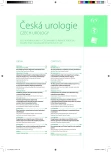The role of pad tests in evaluation of urinary incontinence
Authors:
Jan Krhut 1,2; Peter Zvara 3; Roman Zachoval 4
Authors‘ workplace:
Urologické oddělení FN, Ostrava-Poruba
1; Katedra chirurgických oborů LF OU, Ostrava
2; Division of Urology, University of Vermont, Burlington, VT, USA
3; Urologické oddělení, Thomayerova nemocnice, Praha
4
Published in:
Ces Urol 2012; 16(3): 141-145
Category:
Review article
Overview
Pad testing is a noninvasive and easy to perform method used to detect and quantify urine leakage. A short term pad test is generally used to identify the presence or absence of leakage. A long term pad test is used to quantify urinary leakage. The one-hour pad test is the only version that has been standardized. Despite this lack of standardization, pad tests are considered to be an important primary diagnostic tool, as well as a method for evaluation of treatment efficacy in both the urological practice and clinical research.
Key words:
pad weight test, urinary incontinence, urodynamic assessment.
Sources
1. Abrams P, Andersson KE, Birder L et al. Fourth International Consultation on Incontinence Recommendations of the International Scientific Committee: Evaluation and treatment of urinary incontinence, pelvic organ prolapse, and fecal incontinence. Neurourol Urodyn 2010; 29: 213–240.
2. James ED, Flack FC, Caldwell KP et al. Continuous measurement of urine loss and frequency in incontinent patients. Preliminary report. Br J Urol 1971; 43(2): 233–237.
3. Sutherst J, Brown M, Shawer M. Assessing the severity of urinary incontinence in women by weighing perineal pads. Lancet 1981; 1(8230): 1128–1130.
4. Abrams P, Blaivas JG, Stanton SL, et al. The standardisation of terminology of lower urinary tract function. The International Continence Society Committee on Standardisation on Terminology. Scand J Urol Nephrol 1988; 114(Suppl): 5–19.
5. Smither AR, Guralnick ML, Davis NB, et al. Quantifying the natural history of post-radical prostatectomy incontinence using objective pad test data. BMC Urol 2007; 7: 2.
6. Foster RT, Anoia EJ, Webster GD, et al. In patients undergoing neuromodulation for intractable urge incontinence a reduction in 24-hr pad weight after the initial test stimulation best predicts long-term patient satisfaction. Neurourol Urodyn 2007; 26: 213–217.
7. Lose G, Rosenkilde P, Gammelgaard J, et al. Pad-weighing test performed with standardized bladder volume. Urology 1988; 32(1): 78–80.
8. Wall LL, Wang K, Robson I, et al. Pyridium pad test for diagnosing urinary incontinence. A comparative study of asymptomatic and incontinent women. J Reprod Med. 1990; 35(7): 682–684.
9. Tennstedt S. Design of the Stress Incontinence Surgical Treatment Efficacy Trial (SISTEr). Urology 2005; 66: 1213–1217.
10. Wu WY, Sheu BC, Lin HH. Comparison of 20-minute pad test versus 1-hour pad test in women with stress urinary incontinence. Urology 2006; 68: 764–768.
11. Costantini E, Lazzeri M, Bini V, et al. Sensitivity and specificity of one-hour pad test as a predictive value for female urinary incontinence. Urol Int 2008; 81: 153–159.
12. Simons AM, Yoong WC, Buckland S, et al. Inadequate repeatability of the one-hour pad test: the need for a new incontinence outcome measure. Br J Obstet Gynaecol 2001; 108: 315–319.
13. Versi E, Orrego G, Hardy E, et al. Evaluation of the home pad test in the investigation of female urinary incontinence. Br J Obstet Gynaecol 1996; 103: 162–167.
14. Victor A, Larsson G, Asbrink AS. A simple patient-administered test for objective quantitation of the symptom of urinary incontinence. Scand J Urol Nephrol 1987; 21(4): 277–279.
15. Abdel-fattah M, Barrington JW, Youssef M. The standard 1-hour pad test: does it have any value in clinical practice? Eur Urol 2004; 46(3): 377–380.
16. Franco AV, Lee F, Fynes MM. Is there an alternative to pad tests? Correlation of subjective variables of severity of urinary loss to the 1-h pad test in women with stress urinary incontinence. BJU Int 2008; 102(5): 586–590.
17. Ryhammer AM, Laurberg S, Djurhuus JC, et al. No relationship between subjective assessment of urinary incontinence and pad test weight gain in a random population sample of menopausal women. J Urol 1998; 159(3): 800–803.
18. Karantanis E, Fynes M, Moore KH, et al. Comparison of the ICIQ-SF and 24-hour pad test with other measures for evaluating the severity of urodynamic stress incontinence. Int Urogynecol J Pelvic Floor Dysfunct 2004; 15(2): 111–116.
19. Paick JS, Ku JH, Shin JW, et al. Significance of pad test loss for the evaluation of women with urinary incontinence. Neurourol Urodyn 2005; 24: 39–43.
20. Matharu GS, Assassa RP, Williams KS, et al. Objective assessment of urinary incontinence in women: comparison of the one-hour and 24-hour pad tests. Eur Urol 2004; 45(2): 208–212.
21. Karantanis E, O´Sullivan R, Moore KH. The 24-hour pad test in continent women and men: normal values and cyclical alterations. Br J Obstet Gynaecol 2003; 110: 567–571.
Labels
Paediatric urologist Nephrology UrologyArticle was published in
Czech Urology

2012 Issue 3
Most read in this issue
- Predictive factors for prostate cancer detection using saturation prostate biopsy
- The role of pad tests in evaluation of urinary incontinence
- Non seminoma germ cell tumor (NSGCT) in a non-compliant patient
- The first experience with unilateral barbed suture V-Loc in laparoscopic radical prostatectomy
